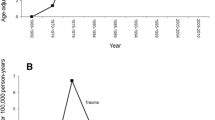Abstract
Introduction
Overwhelming post-splenectomy infection (OPSI) has a 50–70% mortality rate and carries a lifetime risk for the asplenic patient. Specific British guidelines have been developed to reduce its incidence.
Aims
To determine whether British guidelines were being followed in our own institution and what impact they had on overwhelming post-splenectomy infection.
Methods
Retrospective chart review of 100 splenectomies performed by Department of Surgery, Beaumont Hospital from January 1990 to January 2000.
Results
Twenty per cent of patients were discharged without any recommended vaccinations. Prophylactic antibiotics were not prescribed in 53% of patients. Just 12% of charts document a verbal explanation of the complications and management of asplenia to the patient. Overall septic mortality was 12%, of whom 8% died in hospital and 4% after discharge.
Conclusion
Management of the asplenic patient has improved but is far from complete. A central register of asplenic patients and national asplenic guidelines should be established in Ireland to ensure optimum patient care.
Similar content being viewed by others
References
Bridgen ML, Pattullo AL. Prevention and management of overwhelming post-splenectomy infection. An update.Crit Care Med 1999; 27 (4): 836–42.
Holdswoth RJ, Irvin AD, Cuschieri A. Post-splenectomy sepsis and its mortality: Actual versus perceived risk.Br J Surg 1991; 78: 1031–38.
Waghorn DJ. Overwhelming infection in asplenic patients: current best practice measures are not being followed.J Clin Pathol 2001; 54: 214–184.
Working Party of British Committee for Standards in Haematology. Guidelines for prevention and treatment of infection with an absent or dysfunctional spleen.BMJ 1996; (312): 430–34.
Davies JM, Barnes R, Milligan D. Update of guidelines for the prevention and treatment of infection in patients with an absent or dysfunctional spleen.Clin Med JRCPL; 2: 440–43.
Pimpl W, Dapunt O, Kaindl H, Thalhauser J. Incidence of septic and thromboembolic related deaths after splenectomy in adults.Br J Surg 1989; 76: 517–21.
Acs G, Furka A, Lesznyak T et al. Surgical consequences of the polytrauma equivalent syndrome to the spleen injuries treatment.Eur Surg Res 2002; 34: 1–99.
Bisharat N, Omari H, Lavi I et al. Risk of infection and death among post-splenectomy patients.J Infect 2001; 43: 182–86.
Poland GA. The prevention of pneumococcal disease by vaccines: promises and challenges.Inf Dis Clin North Am 2001; 15(1): 97–122.
Bridgen ML, Patullo A, Brown G. Pneumococcal vaccine administration associated with splenectomy: the need for an improved education, documentation, and the use of a practical checklist.Amer J Haem 2000; 65: 25–29.
Ejstrud P, Hansen JB, Andreasen DA. Prophylaxis against pneumococcal infection after splenectomy: a challenge for hospitals and primary care.Eur J Surg 1997; 163: 733–38.
Siddins M, Downie J, Wise K et al. Prophylaxis against post-splenectomy pneumococcal infection.Aust N Z J Surg 1990; 60(3): 183–87.
Pickering J, Campbell H. An audit of the vaccination an antibiotic prophylaxis practice amongst patients splenctomised in Lothian.Health Bull 2000; 59: 390–95.
Ramachandra J, Bond Ranaboldo C et al. An audit of post-splenectomy prophylaxis-are following the guidelines.Ann R Coll Surg Eng 2003; 85: 252–55.
Hazelwood M, Kumararatne DS. The spleen: who needs it anyway?Clin Exp Immunol 1992; 82: 327–29.
Butler J, Breiman R, Campbell J et al. Pneumococcal polysaccharide vaccine efficiency: an evaluation of current recommendations.J Am Med Assoc 1993; 270: 1826–31.
Butler J, Breiman R, Campbell J et al. Pneumococcal polysaccharide vaccine efficiency; an evaluation of current recommendations.J Am Med Assoc 1993; 270: 1826–31.
Anonymous. Prevention of pneumococcal disease: recommendations of the advisory committee on immunisation practices (ACIP).Morb Mortal Wkly Rep 1997; 46: 1–24.
Siber GR, Weitzman SA, Aisdenberg AC. Antibody response of patients with Hodgkins disease to protein and polysaccharide antigena.Rev Infect Dis 1981; 3: 144–59.
Howard RJ. Effect of burn injury, mechanical trauma and operation on immune defenses.Surg Clin North Am. 1979; 59: 199–211.
Shatz DV, Schinsky MF, Pais LB et al. Immune responses of splenectomised trauma patients to the 23 valent pneumococcal polysaccharide vaccine at 1 versus 14 days after splenectomy.J Trauma 1998; 44: 760–5.
Department of Health. Immunisation against infectious disease. London: HMSO, 1992: 102.
Cooper CS, Cohen MB, Donovan JF Jr. Splenectomy complicating left nephrectomy.J Urology 1996; 155(1): 37.
Keenan RD, Boswell T, Milligan DW. Do post-splenectomy patients take prophylactic penicillin?Br J Haematol 1999; 105, 509–10.
Woods GM, Jorgensen JH, Waclawiw MA et al. Influence of penicillin prophylaxis on antimicrobial resistance in nasopharyngeal Streptococcus pneumoniae among children with sickle cell.J Pediatr Haematol Oncol 1997; 19: 327–33.
Green JB, Shackford SR, Sise MJ et al. Late septic complications following splenectomy for trauma: a prospective analysis in 144 patients.J Trauma 1986, 26: 999–1004.
Finch RG, Read R. Lifelong penicillin may be ineffective.BMJ 1994; 308: 132.
Waghorn DJ. Prevention of post-splenectomy sepsis.The Lancet 1993: 341: 248.
Maiman LA, Becker MH, Liptak et al. Improving pediatricians compliance enhancing practices. A randomised trial.Am J Dis Children 1998; 142: 773–9.
Palejwala AA, Hong LYC, King D. Under half of doctors know that antibiotic prophylaxis should be life-long.BMJ (312): 656–60.
European Antimicrobial Resistance Surveillance System (EARSS). EARSS activities and updates.Eurosurveillance 2001, Vol. 6; 1.
Spickett GP, Bullimore J, Wallis J, Smith S, Saunders P. Northern Region asplenia register-analysis of first two years.J Clin Pathol 1999 (52): 424–29.
Author information
Authors and Affiliations
Corresponding author
Rights and permissions
About this article
Cite this article
O’Donnell, J., McGreal, G., Daly, P. et al. Management of patients undergoing splenectomy in an Irish teaching hospital: impact of guidelines. Ir J Med Sci 173, 136–140 (2004). https://doi.org/10.1007/BF03167927
Issue Date:
DOI: https://doi.org/10.1007/BF03167927




